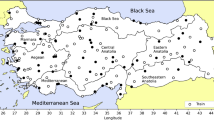Abstract
In this work we compare the performance of a location-specific and a location-agnostic machine learning metamodel for crop nitrogen response rate prediction. We conduct a case study for grass-only pasture in several locations in New Zealand. We generate a large dataset of APSIM simulation outputs and train machine learning models based on that data. Initially, we examine how the models perform at the location where the location-specific model was trained. We then perform the Mann–Whitney U test to see if the difference in the predictions of the two models (i.e. location-specific and location-agnostic) is significant. We expand this procedure to other locations to investigate the generalization capability of the models. We find that there is no statistically significant difference in the predictions of the two models. This is both interesting and useful because the location-agnostic model generalizes better than the location-specific model which means that it can be applied to virgin sites with similar confidence to experienced sites.
Access this chapter
Tax calculation will be finalised at checkout
Purchases are for personal use only
Similar content being viewed by others
References
Albert, A.T., Rhoades, A., Ganguly, S., Feldman, D., Jones, A.D., Prabhat, M.: Towards generative deep learning emulators for fast hydroclimate simulations. In: AGU Fall Meeting Abstracts, vol. 2018, pp. IN21C-0723, December 2018
Garrido Torres, J.A., Jennings, P.C., Hansen, M.H., Boes, J.R., Bligaard, T.: Low-Scaling algorithm for nudged elastic band calculations using a surrogate machine learning model. Phys. Rev. Lett. 122(15), 156001 (2019). https://doi.org/10.1103/PhysRevLett.122.156001
Gillingham, A.G., Morton, J.D., Gray, M.H.: Pasture responses to phosphorus and nitrogen fertilisers on east coast hill country: 2. Clover and grass production from easy slopes. N. Z. J. Agric. Res. 51(2), 85–97 (2008). https://doi.org/10.1080/00288230809510438
Gladish, D.W., Darnell, R., Thorburn, P.J., Haldankar, B.: Emulated multivariate global sensitivity analysis for complex computer models applied to agricultural simulators. J. Agric. Biol. Environ. Stat. 24(1), 130–153 (2018). https://doi.org/10.1007/s13253-018-00346-y
Goetz, J.N., Brenning, A., Petschko, H., Leopold, P.: Evaluating machine learning and statistical prediction techniques for landslide susceptibility modeling. Comput. Geosci. 81, 1–11 (2015). https://doi.org/10.1016/j.cageo.2015.04.007
Holzworth, D.P., et al.: APSIM - evolution towards a new generation of agricultural systems simulation. Environ. Model. Softw. 62, 327–350 (2014). https://doi.org/10.1016/j.envsoft.2014.07.009
Lima, A.R., Cannon, A.J., Hsieh, W.W.: Nonlinear regression in environmental sciences using extreme learning machines: a comparative evaluation. Environ. Model. Softw. 73, 175–188 (2015). https://doi.org/10.1016/j.envsoft.2015.08.002
Lokers, R., Knapen, R., Janssen, S., van Randen, Y., Jansen, J.: Analysis of big data technologies for use in agro-environmental science. Environ. Model. Softw. 84, 494–504 (2016). https://doi.org/10.1016/j.envsoft.2016.07.017
Mann, H.B., Whitney, D.R.: On a test of whether one of two random variables is stochastically larger than the other. Ann. Math. Stat. 18(1), 50–60 (1947). https://doi.org/10.1214/aoms/1177730491
Ramanantenasoa, M.M.J., Génermont, S., Gilliot, J.M., Bedos, C., Makowski, D.: Meta-modeling methods for estimating ammonia volatilization from nitrogen fertilizer and manure applications. J. Environ. Manage. 236, 195–205 (2019). https://doi.org/10.1016/j.jenvman.2019.01.066
Ramankutty, P., Ryan, M., Lawes, R., Speijers, J., Renton, M.: Statistical emulators of a plant growth simulation model. Clim. Res. 55(3), 253–265 (2013). https://doi.org/10.3354/cr01138
Shahhosseini, M., Martinez-Feria, R.A., Hu, G., Archontoulis, S.V.: Maize yield and nitrate loss prediction with machine learning algorithms. Environ. Res. Lett. 14(12), p. 124026, December 2019. https://doi.org/10.1088/1748-9326/ab5268
Weber, T., Corotan, A., Hutchinson, B., Kravitz, B., Link, R.: Technical note: deep learning for creating surrogate models of precipitation in earth system models. Atmos. Chem. Phys. 20(4), 2303–2317 (2020). https://doi.org/10.5194/acp-20-2303-2020
Zhang, R., Zen, R., Xing, J., Arsa, D.M.S., Saha, A., Bressan, S.: Hydrological process surrogate modelling and simulation with neural networks. In: Lauw, H.W., Wong, R.C.-W., Ntoulas, A., Lim, E.-P., Ng, S.-K., Pan, S.J. (eds.) PAKDD 2020. LNCS (LNAI), vol. 12085, pp. 449–461. Springer, Cham (2020). https://doi.org/10.1007/978-3-030-47436-2_34
Acknowledgements
This work has been partially supported by the European Union Horizon 2020 Research and Innovation programme (Grant #810775, Dragon); the Wageningen University and Research Investment Programme “Digital Twins” and AgResearch Strategic Science Investment Fund (SSIF) under “Emulation of pasture growth response to nitrogen application”.
Author information
Authors and Affiliations
Corresponding author
Editor information
Editors and Affiliations
Rights and permissions
Copyright information
© 2021 Springer Nature Switzerland AG
About this paper
Cite this paper
Pylianidis, C., Snow, V., Holzworth, D., Bryant, J., Athanasiadis, I.N. (2021). Location-Specific vs Location-Agnostic Machine Learning Metamodels for Predicting Pasture Nitrogen Response Rate. In: Del Bimbo, A., et al. Pattern Recognition. ICPR International Workshops and Challenges. ICPR 2021. Lecture Notes in Computer Science(), vol 12666. Springer, Cham. https://doi.org/10.1007/978-3-030-68780-9_5
Download citation
DOI: https://doi.org/10.1007/978-3-030-68780-9_5
Published:
Publisher Name: Springer, Cham
Print ISBN: 978-3-030-68779-3
Online ISBN: 978-3-030-68780-9
eBook Packages: Computer ScienceComputer Science (R0)





